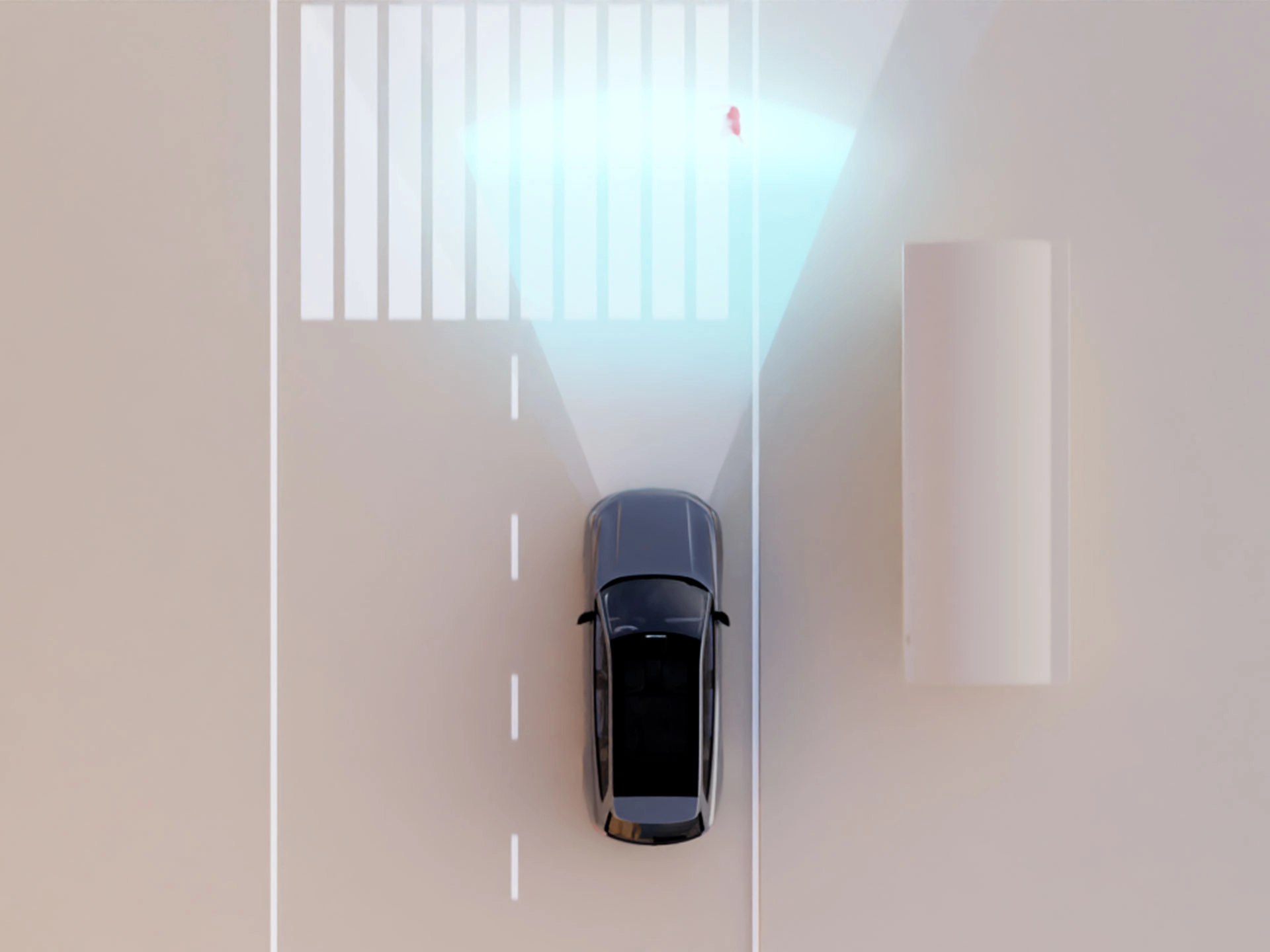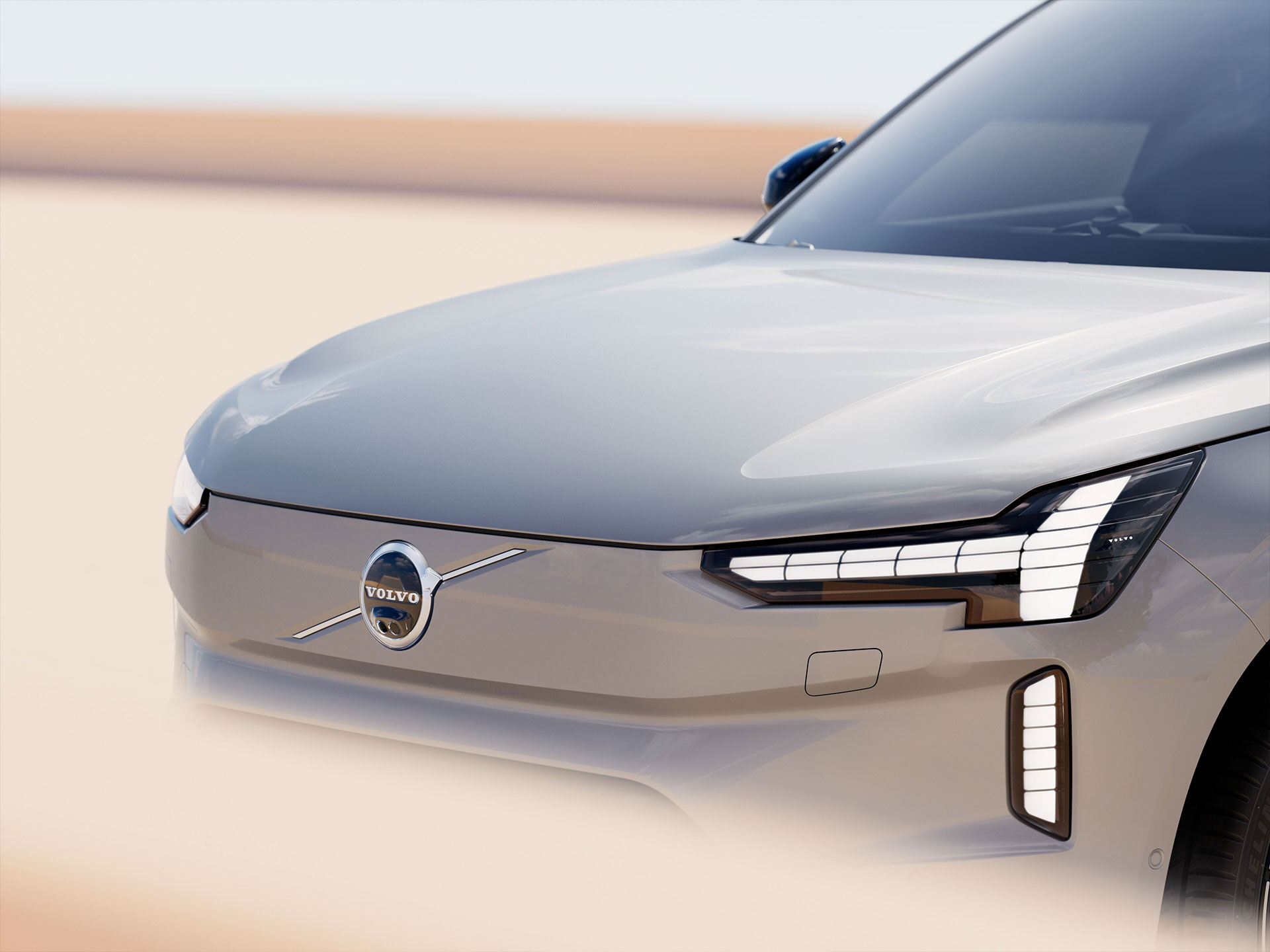Volvo electric cars
Everything you love about driving. Zero tailpipe emissions.
Designed fully electric. Ready for the future of driving
Elevated electric driving
We've looked over the horizon to develop a range of cars that elevate electrification. Instead of simply adapting what's come before, we design and engineer electric cars that deliver a new way to enjoy life on the road.
Singular electric exteriors
Volvo electric car exteriors take our signature Scandinavian design style in a striking direction. Exteriors are bold and contemporary with sleek colour-coordinated shields and aerodynamically optimised wheels and wing mirrors for improved efficiency.
Renewable and recycled materials
The upholsteries and décor featured in our electric car interiors apply renewable and recycled materials in elegant new ways. Transformed into premium materials, they enrich the minimalistic interior architecture of our luxury cabins.
Explore our fully electric range
Our next-generation powertrains and rapid onboard chargers are engineered to deliver more range on a single charge and make every top-up more efficient.
Get automatic charging reminders on the road when your battery hits 20 per cent. You can also get reminders when you don’t plug in at saved charging locations via the Volvo Cars App.
Select a charging station, and your car will heat or cool the battery to the optimal temperature for rapid charging. You don’t have to do anything. Battery pre-conditioning is automatic when your car has a 20 per cent charge or more.
Engineered for more confident electric driving.

Easily integrate charging into your daily routine with a little help from your fully electric Volvo car.
Innovative batteries. On the cutting edge of energy.
Advanced battery safety
Our commitment to safety extends to electric car batteries. That’s why we develop and produce the battery packs and systems used in our range of fully electric cars. Using Battery Management Systems, we also monitor and regulate how batteries function during normal operation.
Battery production and recycling
Batteries are the most carbon-intensive component in our electric cars. By managing the entire production value chain and recycling, we help ensure battery production is as circular as possible and avoid batteries going to a landfill at the end of their lives.
8-year battery warranty
New Volvo electric cars have an extended battery warranty valid for eight years or 160,000km (or whichever comes first). During the warranty period, we guarantee 70 per cent state-of-health, an indicator of the battery’s energy storage capacity. That means a high level of performance, guaranteed.

Advanced safety features
Drive with peace of mind knowing your electric car is equipped with advanced innovations designed to keep you and your loved ones safe on the road.

Take the guesswork out of charging
Stress less about charging with the Volvo Cars app. Simple displays and controls help you find public chargers, check charging status, schedule charging and more. Learn about more time-saving app features.

Maximise your electric range
Use our interactive electric car range calculator to find out what distance a Volvo electric car can travel.

Calculate your savings
Find out how a Volvo fully electric car can deliver financial benefits and reduced running costs.
Our Finance Options
With Subscription and Lease you will not own the vehicle. With Volvo Loan there is a risk of the vehicle value depreciating quicker than anticipated.
What do you want to know about Volvo fully electric cars?
How do electric cars work? 
Electric cars work by using a battery to store electrical energy that powers an electric motor. This motor converts the energy to propel the car's wheels. Electric cars do not rely on burning fuel to generate power. Instead, they capture and store energy through charging and regenerative braking.
How can I charge my electric car at home? 
We recommend a Volvo Cars wallbox. It delivers faster, more efficient charging than a regular wall socket.
Wallboxes have an integrated cable holder and a 5-metre charging cable with a Type 2 socket (IEC 62196), making it compatible with all fully electric Volvo cars.
Have your wallbox installed indoors or outdoors. It's water resistant, and you can purchase a pedestal to install the wallbox where a wall surface isn't available.
Connect to the wallbox via Wi-Fi to see charging status, schedule charging, and more using your smartphone, computer or tablet.
Dynamic LED lighting on the front of the wallbox uses different colours to help you check your charging status at a glance.
How long does it take to charge at home? 
Charging times depend on a few factors, including the charging equipment you use, the battery’s initial charge level, and the level you’re after.
We recommend keeping your battery charged above 20 per cent and only charging up to 90 per cent. This can help reduce charging times (0 to 10 per cent and 90 to 100 per cent take the longest) and help protect the battery health.
Enjoy fast, efficient at-home charging with a Volvo Cars wallbox. Install yours indoors or outdoors and use the Volvo Cars app to schedule charging off-peak when energy tariffs can be lower.
How much does it cost to charge a fully electric car at home? 
Electric car charging costs vary depending on where you live and when you charge. However, driving a fully electric car can deliver significant savings because electric charging typically costs less than petrol or diesel.
Reduce running costs further by scheduling at-home charging when energy tariffs are lowest.
In some markets, Volvo car drivers can benefit from exclusive discounts at public charging stations. Learn more about charging your Volvo car.
Are there public charging discounts for Volvo drivers?
In many markets, Volvo car drivers enjoy discounts on public charging within partner networks. Learn more about discounted public charging.
Does Volvo Cars have its own charging stations?
Some Volvo Car retailers now feature rapid charging stations. Enjoy discounted charging rates when you choose a Volvo charging station.
How does the car help me to find the nearest charging station? 
Use the centre console or the Volvo Cars app to search Google Maps for nearby charging stations. Filter by availability, charger speed, charging network and price. When you’ve selected a destination, you’ll get turn-by-turn navigation.
In some car models, you’ll see the expected charge level on arrival, and your car’s battery will automatically be pre-conditioned. This ensures the battery is at the optimal temperature for efficient charging.
Available where Google Services are available.
Which Volvo electric car has the longest range? 
The EX90, our fully electric 7-seater SUV, has the longest electric range of up to 600 km.*
*The figures are preliminary and derive from estimates and calculations performed by Volvo Cars for Volvo EX90 and these outcomes are not guaranteed. The driving range and energy consumption under real conditions vary depending on driving behaviour and other external factors. Charging times can vary and are dependent on factors such as outdoor temperature, battery temperature, charging equipment, battery condition and car condition. Vehicle certification pending.
Is there a warranty for Volvo fully electric car batteries? 
When you buy a new fully electric Volvo car, your battery is covered by a warranty for eight years or 160,000km, whichever occurs first, where the car and battery are maintained and operated according to the recommendations of Volvo Cars.
Can the battery be replaced? 
The battery and battery modules can be replaced like any other technical part of the car.
How does the battery impact safety in a collision? 
The battery adds around 500 kg of weight to our fully electric cars. This changes how a collision would impact the passengers in the car and the other vehicles involved. Batteries must also be protected to avoid harmful leakages after a collision. Utilising a range of innovative safety solutions, engineers at Volvo Cars have designed fully electric cars that meet these challenges.
How much maintenance and service are needed for a fully electric Volvo car? 
The electric motors in our fully electric cars are sealed for life. With no moving parts or fluids to refill, they are maintenance-free. That means, compared to a car with a combustion engine, fully electric Volvo cars need much less maintenance.
Is the lifecycle carbon footprint of a full electric Volvo car less than an equivalent internal combustion engine vehicle? 
Over the average lifetime of a vehicle, the carbon footprint of a fully electric vehicle (BEV) is less than that of a traditional internal combustion engine vehicle (ICE). However, the distance needed to be driven for a BEV to become less carbon-intensive than an ICE vehicle largely depends on how the electricity that power the vehicle is generated.
If you charge your BEV with renewable electricity, you will need to drive less for that point to be reached, compared with if you use electricity generated from fossil fuels. We encourage you to power your electric vehicle with electricity from renewable sources.
We are committed to full transparency regarding the full carbon impact of our electric vehicles. A lifecycle analysis (LCA) is available for some of our fully electric cars. View the product description page for the fully electric Volvo car you’re interested in to learn more.
How can I know that the car’s battery has been produced in an environmentally and socially responsible way? 
Volvo Cars maintains a strong focus on the battery raw material supply chain to enable responsible sourcing. In 2019, we launched blockchain to enable traceability from the mine to the car of the cobalt used in our batteries. Since then, the scope has widened to include nickel, lithium, and tracking carbon emissions.
We also have an audit program covering battery supply chain suppliers. Audits are conducted against the OECD Due Diligence Guidance for Responsible Supply Chains of Minerals from Conflict-affected and High-risk Areas and the IRMA Standard for Responsible Mining Critical Requirements or equivalent schemes for mines.
Sustainability performance is a key consideration when assessing and selecting our suppliers. We continuously monitor the performance of our existing suppliers and work with them to improve the sustainability performance of our products and services.
Read more in the Volvo Car Group Code of Conduct for Business Partners and Volvo Car Group Annual and Sustainability Report (pages 172 to 17).

The alternative route
Choose a plug-in hybrid to go electric with a combustion engine as backup when you need it.

